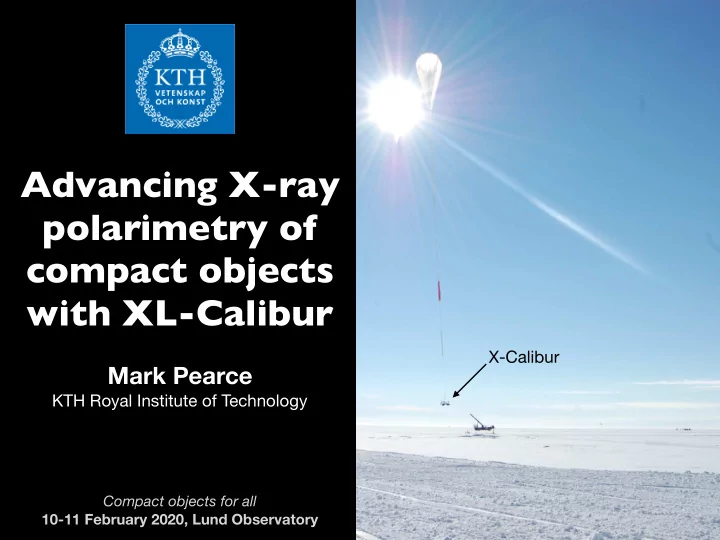

Advancing X-ray polarimetry of compact objects with XL-Calibur X-Calibur Mark Pearce KTH Royal Institute of Technology Compact objects for all 10-11 February 2020, Lund Observatory
X-ray telescope X-ray lens Detector, e.g. CZT X-rays Pixel co-ordinate Deposited energy Time ..100110.. Image Light curve Energy spectrum
X-ray polarimeter { Pixel co-ordinate Scattered beam Deposited energy X-ray lens Time CZT X-rays Be Polarimeter ..100110.. Source symmetry/geometry Polarisation Fraction (PA, %) + Polarisation Angle (PF , °) Source orientation (Image) Light curve Energy spectrum
X-ray polarimeter { Pixel co-ordinate Scattered beam Deposited energy X-ray lens Time CZT X-rays Be Polarimeter ..100110.. # photons Modulation factor Polarization Distribution of fraction azimuthal d α = 1 dN 2 ( 1 + μ cos α ) ; ¯ μ ∼ 0.5 scattering angles ( α ) encodes the polarisation properties of the X-ray a beam 0 2 π Polarisation angle
McMurdo, Antarctica December 2018 WASP: 8 m long truss Wallops ArcSecond Pointer (carbon fibre rods Pointing stability < 1” (RMS) + aluminium joints) X-ray polarimeter InFOC μ S X-ray mirror 50 cm 2 @ 30 keV (255 Pt/C coated Al shells) Observation of GX301-2 apastron flare ApJ (to appear) / arXiv:2001.03581 X-Calibur: 15-60 keV spectroscopy, timing and polarization
X-Calibur → XL-Calibur XL-Calibur (1) New X-ray mirror 3-10 x larger effective area FFAST (Hitomi) InFOC S µ 300 cm 2 X-Calibur 180 cm 2 (InFOC 𝜈 S) ] 2 2 10 • Focal length =12 m Effective area [cm 130 cm 2 • Half-power-diameter = ~1.7 arcmin • Field-of-view = 10 arcmin 10 K-edge Pt ⇒ Improve source statistics 1 20 30 40 50 60 70 80 90 100 Energy [keV] (2) Upgrade polarimeter Collimator CsI(Na) anticoincidence shield plug PMT • Energy range: 15-80 keV Harvester board • Δ E/E (40 keV): ~5 keV (FWHM) Be scattering rod CZT detector CsI(Na) • Thinner CZT detectors (2 mm → 0.8 mm) anticoincidence shield body • Lower anticoincidence energy threshold { Digitiser PMT (atmospheric γ ). More compact design. board PC/104 17th CZT computer detector ⇒ Decrease background
A new era in hard X-ray polarimetry XL-Calibur ~2000 kg / ~500 W MDP day (500 mCrab) ~1% Unpolarised beam has 1% probability of yielding PF > MDP X-ray mirror Pointing system Stability: 1” RMS Knowledge: <15” Alignment/star cameras 12m long truss Carbon fibre tubes and Al joints Focal spot movement < 3 mm Polarimeter
e.g. M. Chauvin et al., Nat. Sci. Rep. 7 (2017) 7816 / Nat. Astr. 2 (2018) 652 / MNRAS 477 (2018) L45/ MNRAS 483 (2019) L138. Cygnus X-1 Crab PoGO+: “MDP” ~10% (~1 week) Launch Landing July 12th 0317 UT July 18th 2226 UT 2016
Flight opportunities Victoria Island McMurdo Esrange ~5-7 days (to Victoria Island) ~8-55 days May/June/July December/January NET summer 2022 NET end-2021 Several flights foreseen - flight programme TBD
Esrange • Crab pulsar • Rotation powered pulsar • Phase-resolved polarimetry • Differentiate emission models 22 PoGO+ (20 - 160keV) Two-pole caustic model ] -1 20 SPI (100 keV - 1 MeV) Outer gap model s -2 IBIS (200 - 800 keV) XL-Calibur 100ksec 18 erg cm OSO-8 (2.6 & 5.2 keV) Min. Det. Polarization 16 • Cygnus X-1 (hard spectral state) 14 -9 [10 12 • Black hole binary 10 E E f • Discern geometry of X-ray bright 8 black hole corona. 50 Pol. Fraction [%] 40 PoGO+ Upper Limit 30 10 20 10 4 Polariztion [%] 3 80 2 60 Pol. Direction 40 1 20 0 Cyg X-1, XL-Calibur 100ksec 20 − 0.4 40 1 for 5% polarization σ − 0.3 60 MDP 99% confidence − 0.2 80 − 0 0.1 0.2 0.3 0.4 0.5 0.6 0.7 0.8 0.9 1 100 1000 Phase Flux [mCrab]
McMurdo GX 301-2 and Vela X-1 14 1 XL-Calibur 300ksec X-Calibur 2018/19 ] X-Calibur [arb. units] -1 12 s 0.8 -2 10 erg cm • Highly magnetised neutron 0.6 8 stars 6 -9 0.4 [10 4 • Constrain beam geometry E E f 0.2 2 • Tests of QED vacuum Fan beam Pencil beam polarization. 0.5 Min. Det. Polarization Pol. Fraction 0.4 0.3 0.2 0.1 0 0 0.1 0.2 0.3 0.4 0.5 0.6 0.7 0.8 0.9 1 Phase σ ( ∥ B, ⊥ B) PF ~ 20% PF ~ 0%
IXPE XL-Calibur (2-8 keV) (15-80 keV) XL-Calibur IXPE • NASA Small Explorer mission, IXPE • 2-8 keV (photoelectric polarimeter) • 30” imaging (4 m) • Launch ~April 2021
Outlook • During the next decade X-ray polarimetry will become an established tool in astrophysics • The IXPE satellite (launch 2021) will address the soft X-ray band (2-8 keV) • Balloon-borne missions play an important role in the hard X-ray band (~15-80 keV). • XL-Calibur is a second-generation balloon mission providing hard X-ray spectro-polarimetry for the IXPE era.
The X-Calibur & XL-Calibur Teams Q. Abarr, H. Awaki (Ehime), R. Bose, D. Braun, G. de Geronimo, P. Dowkontt, T. Enoto, M. Errando, Y. Fukazawa, T. Gadson, V. Guarino, S. Gunji, K. Hayashida (GSFC), S. Heatwole, M. Ishida (ISAS), N.K. Iyer, F. Kislat (UNH), M. Kiss, T. Kitaguchi, H. Krawczynski (WUSTL, PI), R. Kushwah, R.J. Lanzi, S. Li, L. Lisalda, Y. Maeda (ISAS), H. Matsumoto (Osaka), T. Miyazawa, T. Mizuno, T. Okajima (GSFC), M. Pearce (KTH), Z. Peterson, B. Rauch, F. Ryde, Y. Saito, T.-A. Stana, D. Stuchlik (WFF), H. Takahashi (Hiroshima), T. Tamagawa, K. Tamura (Nagoya), H. Tsunemi, M. Tsutsumi, N. Uchida, K. Uchiyama, A. West, Y. Zhou
Recommend
More recommend